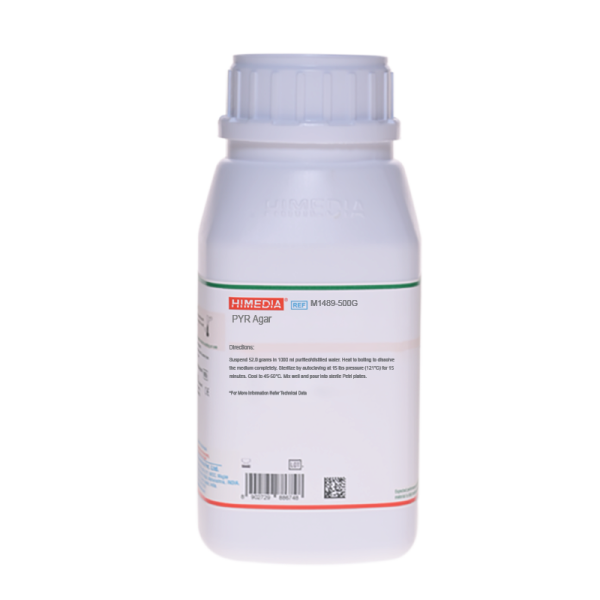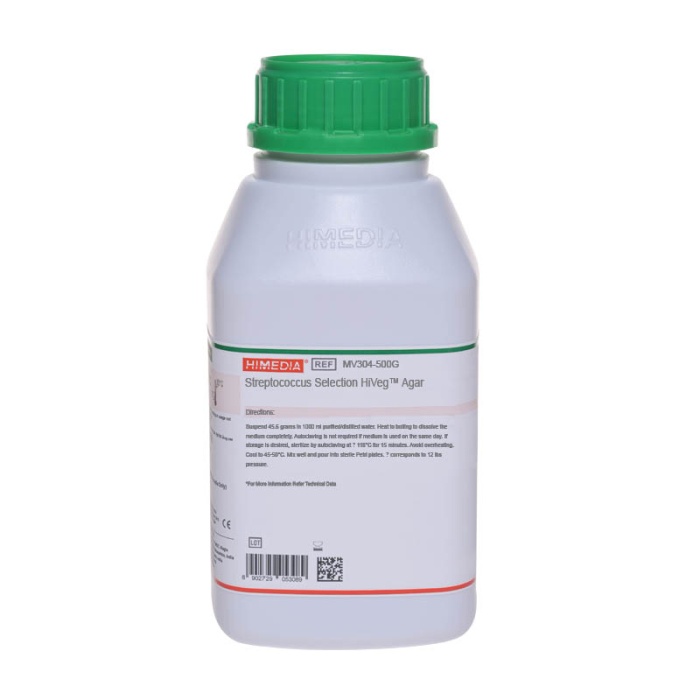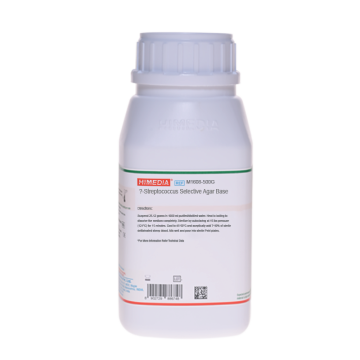 Your enquiry has been submitted
Your enquiry has been submitted
PYR Agar
Intended Use
Recommended for isolation and identification of Streptococcus pyogenes from clinical and non-clinical samples.
Composition
**Formula adjusted, standardized to suit performance parameters
| Ingredients | g / L |
|---|---|
| HM infusion B from 500g # | 10.000 |
| Peptone | 20.000 |
| Dextrose (Glucose) | 2.000 |
| Sodium chloride | 2.000 |
| Disodium hydrogen phosphate | 0.400 |
| Sodium carbonate | 2.500 |
| Chromogenic mixture | 0.100 |
| Agar | 15.000 |
Final pH ( at 25°C): 7.8±0.2
# Equivalent to Beef heart, infusion from
Directions
Suspend 52.0 grams in 1000 ml purified/distilled water. Heat to boiling to dissolve the medium completely. Sterilize by autoclaving at 15 lbs pressure (121°C) for 15 minutes. Cool to 45-50°C. Mix well and pour into sterile Petri plates.
Principle And Interpretation
PYR hydrolysis is a presumptive test for both group A and group D enterococcal streptococci (1). The PYR test determines the activity of enzyme L-pyrrolidonyl arylamidase (PYR) produced by Streptococcus pyogenes but not by other β-haemolytic streptococci (2). Free b-napthylamide is then detected by addition of the diazo dye complex, N,N dimethylaminocinnamaldehyde. Development of a red colour is indicative of PYR hydrolysis (3). PYR test is a highly sensitive test, which replaces bacitracin and salt tolerance (growth in 6.5% NaCl) tests (1). PYR Agar is recommended for detection and presumptive identification of S. pyogenes based on PYR hydrolysis (4).
Todd Hewitt Broth Base (M313) acts as the basal medium to which the agar and substrate for PYR enzyme are added (5). HM infusion B from and peptone provide nitrogenous nutrients. Dextrose is the carbohydrate serving as an energy source. Disodium phosphate serves as buffering agent and sodium chloride maintains osmotic balance. Chromogenic mixture provides substrate for PYR enzyme. After an incubation at 35-37°C for 18-24 hours, add 1 drop of PYR reagent (R043) directly to suspected surface growth on plate. Observe for colour change after 2 minutes. The chromogenic mixture is hydrolysed by S.pyogenes to L-pyrrolidone and b-naphthylamine. The PYR reagent reacts with b-naphthylamine to form a red coloured Schiffs Base indicating a positive reaction.
Type of specimen
Isolated Microorganism from clinical and non-clinical sample.
Specimen Collection and Handling
For clinical sample follow appropriate techniques for handling specimens as per established guidelines (2,3). After use, contaminated materials must be sterilized by autoclaving before discarding.
Warning and Precautions
In Vitro Diagnostic use only. For professional use only. Read the label before opening the container. Wear protective gloves/protective clothing/eye protection/ face protection. Follow good microbiological lab practices while handling specimens and culture. Standard precautions as per established guidelines should be followed while handling clinical specimens. Safety guidelines may be referred in individual safety data sheets.
Limitations
- A false-negative test can result if the disk or filter paper are too moist.
- False-negative tests can result if selective media or tube biochemical agars are used to provide inocula.
- Escherichia coli and indole-positive Proteus obtained from media containing a high tryptophan content may yield a blue-green color development. This is a negative result.
- Some less commonly encountered isolates of lactococci and aerococci may be PYRase positive.
- Non-specific colour reactions may occur if results are read after 20 seconds.
Performance and Evaluation
Performance of the medium is expected when used as per the direction on the label within the expiry period when stored at recommended temperature.
Quality Control
Appearance: Cream to yellow homogeneous free flowing powder
Gelling: Firm, comparable with 1.5% Agar gel
Colour and Clarity of prepared medium: Light yellow coloured clear to slightly opalescent gel forms in Petri plates
Reaction: Reaction of 5.2% w/v aqueous solution at 25°C. pH : 7.8±0.2
pH: 7.60-8.00
Cultural Response: Cultural characteristics observed after an incubation at 35-37°C for 18-24 hours.
| Organism | Inoculum (CFU) | Growth | PYR (on addition of PYR reagent, R044) |
|---|---|---|---|
| Streptococcus pyogenes ATCC 19615 | 50-100 | luxuriant | positive, red colouration |
| Enterococcus faecalis ATCC 29212 (00087*) | 50-100 | luxuriant | positive, red colouration |
| Escherichia coli ATCC 25922 (00013*) | 50-100 | luxuriant | negative |
| Streptococcus agalactiae ATCC 12386 | 50-100 | luxuriant | negative |
Key : *Corresponding WDCM numbers.
Storage and Shelf Life
Store between 15-25°C in a tightly closed container and the prepared medium at 2-8°C. Use before expiry date on the label. On opening, product should be properly stored dry, after tightly capping the bottle in order to prevent lump formation due to the hygroscopic nature of the product. Improper storage of the product may lead to lump formation. Store in dry ventilated area protected from extremes of temperature and sources of ignition Seal the container tightly after use. Product performance is best if used within stated expiry period.
Disposal
User must ensure safe disposal by autoclaving and/or incineration of used or unusable preparations of this product. Follow established laboratory procedures in disposing of infectious materials and material that comes into contact with clinical sample must be decontaminated and disposed of in accordance with current laboratory techniques (5,6).
Reference
- Facklam R. R., Thacker L. G, Fox B., Eriquez L., 1982, J. Clin. Microbiol., 15 (6), a, 987-990.
- MacFaddin J. F., 2000, Biochemical Tests for Identification of Medical Bacteria, 3rd Edition, Lippinocott Williams and Wilkins, N.Y. 407-410.
- Koneman E. W., Allen S. D., Janda W. M., Schreckenberger P. C., Winn W. C. Jr., 1992, Colour Atlas and Textbook of Diagnostic Microbiology, 4th Ed., J. B. Lippinccott Company
- Murray P. R., Baron J. H., Pfaller M. A., Jorgensen J. H. and Yolken R. H., (Eds.), 2003, Manual of Clinical Microbiology, 8th Ed., American Society for Microbiology, Washington, D.C.
- Isenberg, H.D. Clinical Microbiology Procedures Handbook 2nd Edition.
- Jorgensen, J.H., Pfaller, M.A., Carroll, K.C., Funke, G., Landry, M.L., Richter, S.S and Warnock., D.W. (2015) Manual of Clinical Microbiology, 11th Edition. Vol. 1.
| Product Name | PYR Agar |
|---|---|
| SKU | M1489 |
| Product Type | Regular |
| Physical Form | Powder |
| Origin | Animal |
| Packaging type | HDPE |
| References | 1. Facklam R. R., Thacker L. G, Fox B., Eriquez L., 1982, J. Clin. Microbiol., 15 (6), a, 987-990. |
| Customized Product Available | No |








